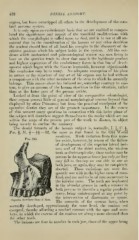Page 428 - My FlipBook
P. 428
438 DENTAL ANAT03IY.
organs, but have outstripped all others in the development of the cere-
bral nervous system.
It is only upon an evolutionary basis that we are enabled to compre-
hend the significance and import of the manifold modifications with
which the morphologist is called upon to deal, and it is not at all un-
natural that in the consideration of the human or any other dentition
the student should first of all bend his energies to the discovery of the
relative position which his subject holds in the system. All the evi-
dence which anatomical and pala?ontological science can now bring to
bear on the question tends to show that man is the legitimate product
and highest expression of the evolutionary forces in that line of devel-
opment which began with the Eocene lemuroids, however objectionable
this conclusion may be to many. No adequate conception of his place
in nature or the structure of any set of his organs can be had without
a comparison with the other members of the stem to which he naturally
belongs. This reason alone has induced me, somewhat contrary to cus-
tom, to give an account of the human dentition in this situation, rather
than at the latter part of the present article.
Looked at from the point of view of the comparative odontologist,
these organs present little of general morphological interest beyond that
displayed by other Primates ; but from the practical standpoint of the
operative dentist they are of the greatest importance. In the course
of this account many questions in connection with this latter phase of
the subject will doubtless suggest themselves to the reader which are not
within the scope of the present ]>art of the work to discuss, its object
being merely to outline the anatomy.
The dental formula of the human subject is, normally, I. f, C. \,
Pm. M. = = 32, the same as that found in the Old World
I, I if
monkeys. Much variation from this num-
"
ber exists, however, by reason of the failure
of development of the superior lateral inci-
sors and of the third molars, the wisdom
teeth or denies mpientkv; these molars may be
present in the upper or lower jaw only, or they
may fail to develop on one side in one or
both jaws, or, again, they may be completely
aborted. These variations are most fre-
quently met with in the higher races of man-
kind, and are said to be of rare occurrence in
the inferior races. The teeth are implanted
in the alveolar process in such a manner in
both jaws as to describe a regular parabolic
curve, being uninterrupted at any point by
the intervention of diastemata or spaces.
Superior Maxillary Bone of Man. —,, -^ i^ ji i i_
Ihe summits ot the crowns have, when
normally developed, approximately the same level, the canines not
excepted, thereby aifording a marked contrast with the apes and mon-
keys, in which the crowns of the canines are always more elevated than
the other teeth.
The incisors are four in number in each jaw, those of the upper being


